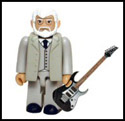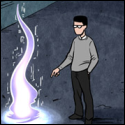|
Rexxed posted:I'm not sure what's up with the disk, but often DC power supplies make the LED blink if they're shorted out or have other over current protection trip. You can check the cable to make sure it's not shorted but given the age and the fact that it's been opened I'm guessing it's not going to successfully power on anymore. I have a bunch of old IDE disks that work fine but I realized buying large CF cards and IDE adapters makes more sense for old systems if I was going to resurrect one. I was able to power up other disks using the same connector, so I'm guessing it's probably not that. Is it possible I just fried something on the PCB? Or shorted it with an inadvertent static shock? I pulled it off to check for a blown capacitor... nothing. I cloned an even older drive last night so I have my fingers crossed that I can do something with this one - I'm basically just looking to pull any data I might want off the drive before I toss it, so I'm not looking to resurrect it per se.
|
|
|
|

|
| # ? May 23, 2024 16:12 |
|
Guitarchitect posted:I was able to power up other disks using the same connector, so I'm guessing it's probably not that. Is it possible I just fried something on the PCB? Or shorted it with an inadvertent static shock? I pulled it off to check for a blown capacitor... nothing. When you take the top off a drive if it's not in a clean room (or most recovery places use a filtered air flow booth thing) you're going to get dust in there that will destroy the platters. You probably will not be able to get data from it at this point without heroic efforts (a second disk of the same type to sacrifice to put the platters in, which likely won't even work at this point).
|
|
|
|
Out of curiosity, how often have you guys had an external drive enclosure fail, but not the drive itself? I just had this happen to one of mine; I removed the drive and put it in a separate enclosure, and it works fine, SMART status is perfect, etc., but when placed back into the first enclosure it no longer powers on. Unrelated, I was reading reviews for a different external HDD and a user wrote about his enclosure failing but the drive being totally fine, just like what happened to me. I hadn't had an issue with an external enclosure failing before (and I rarely have HDDs fail anyways) so I was wondering how much of a thing this is.
|
|
|
|
Nevermind, misunderstood the mechanism. :-)
lllllllllllllllllll fucked around with this message at 11:57 on Jul 7, 2018 |
|
|
|
Rexxed posted:When you take the top off a drive if it's not in a clean room (or most recovery places use a filtered air flow booth thing) you're going to get dust in there that will destroy the platters. You probably will not be able to get data from it at this point without heroic efforts (a second disk of the same type to sacrifice to put the platters in, which likely won't even work at this point). Honestly, that hasn't been my experience - that's why I'm not too fussed about trying it when all else fails. My understanding was always that when the disk spins up, it'll throw anything off of it and there's essentially an air cushion created by the platters' rotation - any dust put into the air ends up getting sucked into the filter pretty quickly. It doesn't mean you should crack drives open and leave them that way, but it also doesn't mean that a quick open/close is catastrophic. Again, I'm not trying to treat this as a drive I can continue to use relentlessly, I'm just hoping to spin it up, pull everything off it that I can, and then toss it.
|
|
|
|
Guitarchitect posted:Honestly, that hasn't been my experience - that's why I'm not too fussed about trying it when all else fails. My understanding was always that when the disk spins up, it'll throw anything off of it and there's essentially an air cushion created by the platters' rotation - any dust put into the air ends up getting sucked into the filter pretty quickly. It doesn't mean you should crack drives open and leave them that way, but it also doesn't mean that a quick open/close is catastrophic. Again, I'm not trying to treat this as a drive I can continue to use relentlessly, I'm just hoping to spin it up, pull everything off it that I can, and then toss it. Years ago, I did have a teacher in a computer lab build a system for education/display use with a HDD that had the cover removed. It worked fine, at least for a while, (i.e. it didn't die while I was there) from what I remember. It's certainly not something I'd do long-term for a system I cared about, but to illustrate the inner workings of an HDD it's quite fascinating.
|
|
|
|
Atomizer posted:Out of curiosity, how often have you guys had an external drive enclosure fail, but not the drive itself? This has been my experience with every LaCie enclosure I've ever worked with. Probably 7 or 8 of them through my professional career. Maybe they've gotten better, but I will won't buy or recommend them.
|
|
|
|
NeuralSpark posted:This has been my experience with every LaCie enclosure I've ever worked with. Probably 7 or 8 of them through my professional career. Maybe they've gotten better, but I will won't buy or recommend them. Ah, ok, good to know. Mine was a Buffalo, which isn't exactly the most common brand (the drive inside is a Seagate 7200 RPM) but it was nice because it had the 1 GB DRAM buffer so it would cache writes as fast as you could send them through the interface.
|
|
|
|
Atomizer posted:Out of curiosity, how often have you guys had an external drive enclosure fail, but not the drive itself? Iíve had this happen with multiple WD externals as well. Too bad itís a complete pain in the rear end to get the externals off at times, but the drives have almost always worked without the enclosures.
|
|
|
|
How would I go about trying to recover some files from a laptop that won't start/boot? I'm mainly interested in the pictures that I have on there. I tried replacing the battery before and that didn't fix the issue of it not starting. I asked someone I work with about it and he said I would need an external hard drive or something to that effect. The laptop is a Toshiba Satellite L505D-S5983 from 2011(?) if that helps. I know it's not guaranteed but I figure it's worth a shot.
|
|
|
|
ServoMST3K posted:How would I go about trying to recover some files from a laptop that won't start/boot? I'm mainly interested in the pictures that I have on there. I tried replacing the battery before and that didn't fix the issue of it not starting. I asked someone I work with about it and he said I would need an external hard drive or something to that effect. The laptop is a Toshiba Satellite L505D-S5983 from 2011(?) if that helps. I know it's not guaranteed but I figure it's worth a shot. First, you need to get the hard-drive out of that laptop (https://www.youtube.com/watch?v=RjEo4SH3N20). Secondly you need to buy a USB hard-drive enclosure (like this https://www.newegg.ca/Product/Product.aspx?Item=0VN-0003-000H3 , but obviously not necessarily that. any would work.) Then you put your HDD into that enclosure and then plug the USB cable into a running computer. Copy files from harddrive. Done.
|
|
|
|
You'll need to remove the hard drive and connect it to another computer. You can use a USB to SATA adapter cable, or put it in a 3.5" enclosure that connects via USB.
|
|
|
|
If the installation is corrupted, I've had great success with File Scavenger. I don't know whether it's worse now than it used to be ten years ago, but it's tried and tested and better than any alternative I found back then.
|
|
|
|
Thank you for the replies! You guys are super helpful!
|
|
|
|
RhoA posted:Iíve had this happen with multiple WD externals as well. Too bad itís a complete pain in the rear end to get the externals off at times, but the drives have almost always worked without the enclosures. Interesting again. Lacie, Buffalo, WD; it seems that enclosures, like individual HDD brands themselves are all probably roughly comparable in terms of reliability and failure rates. In other words, you may have a WD drive that went bad while I might have one that works fine for several years. I never subscribed to the line of thought that went, "I had a [Seagate/Hitachi/WD/etc.] HDD go bad, I'm never going to buy them again." Since my first 400 MB HDD 25 years ago I've had far more good drives (i.e. ones that continued to work fine throughout the point where they were taken out of use simply due to obsoletion by lack of capacity) than bad ones, and if we stopped using a given brand of drive just because one went bad we'd have no brands left to use! Unrelated to the enclosure issue I asked about, I had a separate expansion card problem that I described in greater detail in the Plex thread if anyone's interested, and I took the opportunity to condense my media to one large HDD and port my PMS installation to an SFF PC. I had a couple external drives, both USB2, which are serviceable but definitely bottlenecked by the interface, at around 40 MB/s. I wanted to put them in a faster USB3 enclosure to make them more usable, so I opened up the original enclosures and removed a 2 TB (Hitachi HDS722020ALA330) from one and 2x 500 GB (wd5000aaks) drives from the other; the former is from 10/2009, and the latter are from 08/2007, meaning these drives are still working fine after nearly 9 and 11 years.  The 2 TB was one of the main media storage drives for Plex and was fine over USB2 for occasional read tasks; when I put it in a USB3 enclosure and connected it to the SFF PC to transfer the contents I was only getting ~50 MB/s, which was definitely an improvement over USB2 but still disappointing, so I instead set it aside and transferred the contents of that drive's mirror/backup (which is a newer Seagate USB3) which was easily more than twice as fast (which was significant since the drive was completely full of 2 TB worth of media.) The 2x500 GB dual drive enclosure just held some video that I'm finally getting around to transcoding now, so they were empty at this time and I didn't bother trying to test their speed. All 3 of the old HDDs are 7200 RPM so that read speed was again disappointing, but that's probably due in part to their age and sparsity (compared to modern high-density drives) but also the fact that the drive was probably reading from the inner edges of the platters to begin with (and at the point where I quickly decided to give up on it and use the newer, faster drive with the same contents,) where transfer rates would be slower compared to further towards the outer edges. I checked benchmarks and the WDs are apparently capable of >80 MB/s average sustained R/W and the Hitachi is almost 100 MB/s for the same. When I find a new use for the drives I'm sure they'll be faster overall via USB3 or SATA, so in the end I have no regrets about shucking them. All in all it was a learning experience, and an eye-opener into just how far we've come in terms of storage technology. Recently I've been a strong advocate of "SSDs for the OS, HDDs for media" but after all this I have a much stronger appreciation for solid-state storage now!
|
|
|
|
Just an educated guess, but it seems to me that "media drives" and such simply aren't literally worked to death like system drives. Having a frequently/constantly used OS on it is surely more stressful than just sitting there idly spinning, right? And that's not even accounting for spinning down sometimes, as in many cases. Having said that I've definitely had a couple drives that were system for at least part of their life which lasted waaay past the mtbf, and of course vice versa. In any case yes "brand X drives are crap" is silly, but there certainly is such a thing as a model or line with a bad track record, and I don't just mean the infamous IBM Deathstars. Hipster_Doofus fucked around with this message at 14:02 on Jul 10, 2018 |
|
|
|
Oh I will say, for the most part, my systems aren't running 24/7 so their drives are comparatively underused, but this PMS desktop happens to be a notable exception. Also I only use SSDs for system drives and HDDs for bulk game/media storage. That being said, the secondary desktop in question is idle most of the time so the media drives are only used on occasion. For comparison my ~5.5-year-old gaming desktop has had a 3 TB game drive in it and it's only got ~5.5k hours of power-on time per SMART, which works out to <3 hours per day. The drives connected to the other desktop have closer to 20k hours IIRC due to actually being online 24/7 even if they're not spinning. All that in mind, I remembered I wanted to inquire about what actually wears out HDDs. Is it the constant platter spinning? Or rather frequent spin-ups & -downs? Or is it more about frequent read/write access and operation of the actuator arm? I'd guess it's more the latter two activities.
|
|
|
|
I remember reading somewhere that spin-up is actually the most stressful thing for hard drives, and in fact that it's better for them to just be on all the time. I'm guessing there may have been some truth to that, but not anymore. In the same place, I read that server drives that have run absolutely non-stop for years are sometimes done for the moment you power them down; that they'll never successfully power up again. I'm not making poo poo up or misremembering or anything. Whatever I was reading definitely said these things, but I have never known if they were true and, well, never bothered trying to find out.
|
|
|
|
Hipster_Doofus posted:I remember reading somewhere that spin-up is actually the most stressful thing for hard drives, and in fact that it's better for them to just be on all the time. I'm guessing there may have been some truth to that, but not anymore. I've definitely heard the former before, i.e., spinning up is more demanding than just running constantly. I think that was in the same PC lab I mentioned where the prof opened up a HDD and covered it with a transparent cover to illustrate HDD functionality in a running system. The "server drive dying after powering down" thing may have been true years ago, but modern drives are rated for millions of hours in terms of MTBF; i.e. while a given rating of, say, 1.5 M hours MTBF is only an average, by definition, they wouldn't get that average rating if some of them didn't last for both shorter and longer than that period, and 1.5 M hours is >170 years of 24/7 use, so that tells me that the actual load on the drive is more important than the actual amount of time it's in use.
|
|
|
|
Here's the thing about the spin-up: If the drive is already on and spinning, keeping it spinning uses relatively little force. But starting from a dead stop requires much more initial force to overcome the inertia. That's how a drive can stay working just fine for as long as you never turn it off, the motor's lost its ability to impart the force to spin up, but can more than handle the "keep spinning". So the drive that is frequently stopping and starting up again is going to stop giving you data back way before the drive that's been on for 20 years straight, even though the drive that's been on and spun up for 20 years could have its motor in much worse shape. And once you finally shut off the drive for once, it's not going to start back up. The drive that was frequently stopping and starting probably incurred less wear, but since you were encountering the spin up operation more often you end having it "die" right at the first time the motor was too worn to do the spinup. The drive that was on constantly, you never ended up encountering that failure once it happened, but instead years on.
|
|
|
|
That makes sense, and suggests that motor wear is one of the major things that kills HDDs; the other is probably a sudden head crash due to impact and is more unpredictable. The only thing is the hypothetical "20 years" figure is probably an underestimate based on modern drives (given the advertised millions of hours average before failure,) and an overestimate based on the usefulness of a drive of that age. Without trying to do some excessive research, I'm guessing that in 1998 the average consumer HDD was in the 1-10 GB range, maybe in the low tens of GB, and nowadays would be totally obsolete based on speed and capacity alone. So if there was still a drive of that vintage in running condition, it would've been replaced before dying based on the uselessness of the drive and host PC hardware. I think the fact that I've got a lightly used 2 TB drive from 9 years ago says something about the more limited advances in HDDs and in contrast the more rapid advances in SSD technology.  (Also, I think it's fair to guess those old drives are still probably reasonably reliable based on their limited spin-ups, time in operation, and low powered-on hours.)
|
|
|
|
You seem to forget major airports running critical systems on ancient DOS computers with no option to put in modern hardware out of sheer managerial incompetence. "It's still working, right? Why upgrade to something more reliable and made in this millennium for 5 figures when we can risk tens of millions of lost income and economic damages instead?"
|
|
|
|
Geemer posted:You seem to forget major airports running critical systems on ancient DOS computers with no option to put in modern hardware out of sheer managerial incompetence. "I mean, it's not like it'll be our fault it happens, you were just too incompetent to keep the system running!"
|
|
|
|
Atomizer posted:That makes sense, and suggests that motor wear is one of the major things that kills HDDs; the other is probably a sudden head crash due to impact and is more unpredictable. In 1998 I had a dell with a 13.2gb HD and boy was I happy with my unlimited space
|
|
|
|
Atomizer posted:I think the fact that I've got a lightly used 2 TB drive from 9 years ago says something about the more limited advances in HDDs and in contrast the more rapid advances in SSD technology. Hitachi has the 14tb drive you can buy today and is working on 16tb, 18tb and 20tb drives. There's been a ton of advances in increasing density of platters without modifying the form factors. In those 9 years two different recording styles have been invented, perpendicular recording and shingled recording plus we fill the drives with helium now to achieve these densities. Hard drives are super complicated and it's a miracle they don't all explode all the time
|
|
|
|
FCKGW posted:Hitachi has the 14tb drive you can buy today and is working on 16tb, 18tb and 20tb drives. There's been a ton of advances in increasing density of platters without modifying the form factors. In those 9 years two different recording styles have been invented, perpendicular recording and shingled recording plus we fill the drives with helium now to achieve these densities. Western Digital had a breakthrough with MAMR, microwave assisted magnetic recording, using the same litho techniques they use to make regular read/write heads. Should bump the per platter density up to like 4tb/in^2, with an increase in BoM cost of basically nothing. My next 10-pack of HDDs are gonna be like 20 TB drives, and it's gonna suck so so hard when it comes time to rebuild one.
|
|
|
|
Geemer posted:You seem to forget major airports running critical systems on ancient DOS computers with no option to put in modern hardware out of sheer managerial incompetence. Yeah, I had this kind of thing in mind, and I also thought back on that story about the school that had a student build a system to control the HVAC stuff and it's still running on a C64. (Also, look up the laptop they use to maintain the McLaren F1....  ) There are certainly going to be businesses/organizations that rely on ancient technology, but it will fail eventually, and they're going to have to upgrade sooner or later, whether they like it or not. They're not getting any sympathy from me. ) There are certainly going to be businesses/organizations that rely on ancient technology, but it will fail eventually, and they're going to have to upgrade sooner or later, whether they like it or not. They're not getting any sympathy from me.FCKGW posted:Hitachi has the 14tb drive you can buy today and is working on 16tb, 18tb and 20tb drives. There's been a ton of advances in increasing density of platters without modifying the form factors. In those 9 years two different recording styles have been invented, perpendicular recording and shingled recording plus we fill the drives with helium now to achieve these densities. I know that we've made breakthroughs in HDD technology over the past decade, but I was referring more broadly to the fact that the one I was talking about overlaps with drives you can buy new today. The old drive still works fine, and is just a little slower than something with higher density, and certainly is within the range of capacities still being sold or shipped with new systems. Methylethylaldehyde posted:Western Digital had a breakthrough with MAMR, microwave assisted magnetic recording, using the same litho techniques they use to make regular read/write heads. Should bump the per platter density up to like 4tb/in^2, with an increase in BoM cost of basically nothing. My next 10-pack of HDDs are gonna be like 20 TB drives, and it's gonna suck so so hard when it comes time to rebuild one. That's the glaring thing I've learned this past week or so: despite the fact that modern HDDs have sequential performance of >200 MBps, that's still s l o w considering how long it would take to fill them up. I mean, just as an example, I looked up a Seagate Pro 12 TB 7.2k RPM with "up to 250 MBps sequential performance" and that translates to 13-14 hours to fill the whole thing at the rated speed, and if the source drive can keep up. 
|
|
|
|
Yeah that's a whole separate issue of platter disks. Samsung has had a 2.5 inch form factor SAS-attached SSD available at 30 terabytes for nearly 6 months now. It reads at ~2200 megabytes per second and writes at ~1700, so you can fill it in 5 hours. Incidentally, it will run you around $16,000 to buy, but hey the lower capacity variants will be nearly as fast when they're available but much cheaper.
|
|
|
|
What form factor of motherboard is this? ITX, mini-ITX, or something else? Or is it a proprietary design?
|
|
|
|
TITTIEKISSER69 posted:What form factor of motherboard is this? ITX, mini-ITX, or something else? Or is it a proprietary design? That's proprietary. HP and a lot of the other manufacturers will produce custom motherboards for some of their unusual case designs. I'm guessing that was in an all-in-one or a small form factor desktop due to the position of the external jacks along the top and side, the RAM slots for so-dimms, lack of an ATX power connector, etc.
|
|
|
|
Yes, it was my mother's old HP AIO. I was hoping I could put a non-anemic motherboard in it. That one has a grand total of 1 CPU upgrade possible, an increase of 50 Mhz.
|
|
|
|
TITTIEKISSER69 posted:Yes, it was my mother's old HP AIO. I was hoping I could put a non-anemic motherboard in it. That one has a grand total of 1 CPU upgrade possible, an increase of 50 Mhz. What model is it and what kind of harddrive and how much RAM does it have? CPU performance isn't usually a problem.
|
|
|
|
It's an HP 100B AIO. I have an SSD I can swap in, and my old laptop RAM might work, but it's rather moot as she has a much nicer Dell 9020 AIO now. Anyway the CPU is a netbook class AMD E-350, so I'm not going to put my spare parts into a 7 year old machine with no further upgrade path. If I could put in a conventional motherboard (requiring case mods, fine) then I'd consider it.
|
|
|
|
TITTIEKISSER69 posted:It's an HP 100B AIO. I have an SSD I can swap in, and my old laptop RAM might work, but it's rather moot as she has a much nicer Dell 9020 AIO now. Anyway the CPU is a netbook class AMD E-350, so I'm not going to put my spare parts into a 7 year old machine with no further upgrade path. If I could put in a conventional motherboard (requiring case mods, fine) then I'd consider it. I was going to say, it definitely looked like an AIO based on the perpendicular ports, and those AIOs are basically laptop hardware in a desktop. However: TITTIEKISSER69 posted:It's an HP 100B AIO. I have an SSD I can swap in, and my old laptop RAM might work, but it's rather moot as she has a much nicer Dell 9020 AIO now. Anyway the CPU is a netbook class AMD E-350, so I'm not going to put my spare parts into a 7 year old machine with no further upgrade path. If I could put in a conventional motherboard (requiring case mods, fine) then I'd consider it. You could've stopped there, as that's a garbage CPU and not worth your time. If she didn't already have a replacement for that system I'd recommend an inexpensive laptop (acer e15 e5-575-33bm).
|
|
|
|
Atomizer posted:That's the glaring thing I've learned this past week or so: despite the fact that modern HDDs have sequential performance of >200 MBps, that's still s l o w considering how long it would take to fill them up. I mean, just as an example, I looked up a Seagate Pro 12 TB 7.2k RPM with "up to 250 MBps sequential performance" and that translates to 13-14 hours to fill the whole thing at the rated speed, and if the source drive can keep up. That's peak performance at the edge of the disk too. What's interesting is the read rate is 100% limited by the rotation speed, not the read head limitations. So if you really wanted to get MAXIMUM GAINZ, you could run a 15k screamer with higher end DSPs and probably get 400MB/sec peak read speed out of it. There's actually talk of adjusting the disk size slightly internally and wedging two complete read/write heads inside a standard 3.5" drive. The other solution is splitting the read head into an upper and lower head pack, so you can get twice the IOPS, and twice the throughput, at the cost of probably having two separate logical disks. If they manage to get dual actuator 20 TB disks for sale in the next year or two, I'm gonna be so happy. Finally a reason to get 12gb SAS!
|
|
|
|
Atomizer posted:I was going to say, it definitely looked like an AIO based on the perpendicular ports, and those AIOs are basically laptop hardware in a desktop. However: You should just change your username or custom title to that Acer
|
|
|
|
Atomizer posted:That's the glaring thing I've learned this past week or so: despite the fact that modern HDDs have sequential performance of >200 MBps, that's still s l o w considering how long it would take to fill them up. I mean, just as an example, I looked up a Seagate Pro 12 TB 7.2k RPM with "up to 250 MBps sequential performance" and that translates to 13-14 hours to fill the whole thing at the rated speed, and if the source drive can keep up. Yeah, welcome to my world. Lawyer breathing down my neck, police officers itching to get out of there, suspect getting angrier by the minute - "How long are you going to be? Well, another 6 hours imaging this hard drive..."
|
|
|
|
Methylethylaldehyde posted:That's peak performance at the edge of the disk too. What's interesting is the read rate is 100% limited by the rotation speed, not the read head limitations. So if you really wanted to get MAXIMUM GAINZ, you could run a 15k screamer with higher end DSPs and probably get 400MB/sec peak read speed out of it. That's actually a very cool solution; I've wondered why they can't put another actuator stack in the adjacent corner of the drive, though. The only thing that's typically there is the conduit for the ribbon cable, and that seems like it could be re-routed. Then the actuator arms could access opposite side of the platters.  Statutory Ape posted:You should just change your username or custom title to that Acer I should; hmm... we can put hyperlinks in custom titles, right? I have been looking for a new custom title/avatar, after all....  The only thing giving me pause is that I'm not sure if that -33BM model is actually discontinued now in favor of the Coffee Lake refresh. The "replacement" is the E5-576-392H, which costs more, loses the backlit keyboard, and uses DDR3 instead of DDR4 for some reason, and I don't think the slightly better CPU and a little more RAM are worth what you lose. Gromit posted:Yeah, welcome to my world. Lawyer breathing down my neck, police officers itching to get out of there, suspect getting angrier by the minute - "How long are you going to be? Well, another 6 hours imaging this hard drive..." Lol, why can't criminals all upgrade to SSDs before committing their crimes?!?
|
|
|
|
Platter HDDs are all about $/Gb, the performance crowd moved on to SSDs long ago. Adding more heads trying to squeeze out performance ainít happening.
|
|
|
|

|
| # ? May 23, 2024 16:12 |
|
Well no, what we're discussing is that as HDD capacity increases, the drives become less usable because performance doesn't scale with capacity. That means that for as much capacity as you might have (or need,) it takes hours upon hours to actually access that volume of data. Increasing performance is desirable just to make use of that extreme capacity; HDD performance is never going to match up to SSDs.
|
|
|


























